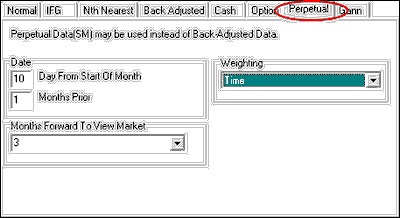The original formula uses Time Weighting and represents a weighted average of the two contracts of the same commodity that lie adjacent to a given period-forward point in time, avoiding the volatile expiring market period and the quiet illiquid period of a contract's history.
The alternative Perpetual Contract series uses Open Interest Weighting to blend all contracts, with emphasis on those with the greatest open interest.
Either way, Perpetual Contract Data can continuously focus on the center of market volume and liquidity, and effectively take the market's pulse over an indefinite period. Unlike nearest future contracts, this computed contract has no abrupt jumps or drops in price. Use this concept to study a market's characteristics over time without concern for contract expiration or the following of complex contract roll-forward rules.
The user settings for Perpetual Contract Data are shown here:

You'll need to select the appropriate response for each of the following:
Date